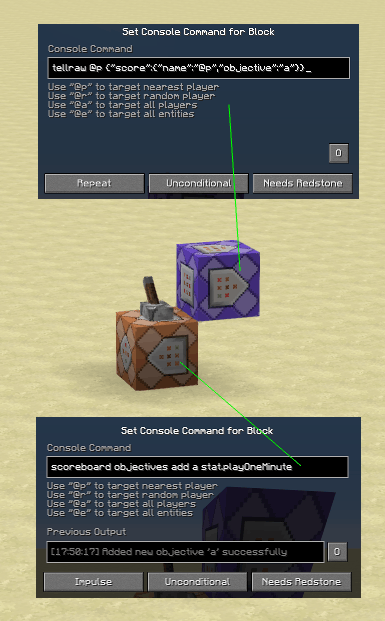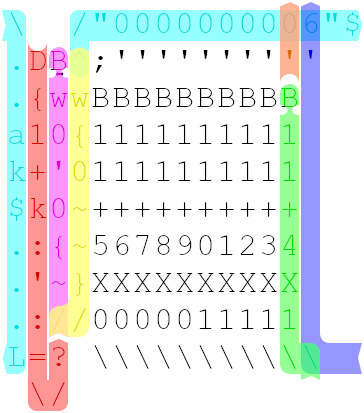71
8
Write a program that counts up forever, starting from one.
Rules:
- Your program must log to
STDOUTor an acceptable alternative, ifSTDOUTis not available. - Your program must be a full, runnable program, and not a function or snippet.
- Your program must output each number with a separating character in between (a newline, space, tab or comma), but this must be consistent for all numbers.
- You may print the numbers in decimal, in unary or in base 256 where each digit is represented by a byte value.
- Your program must count at least as far as 2128 (inclusive) without problems and without running out of memory on a reasonable desktop PC. In particular, this means if you're using unary, you cannot store a unary representation of the current number in memory.
Unlike our usual rules, feel free to use a language (or language version) even if it's newer than this challenge. Languages specifically written to submit a 0-byte answer to this challenge are fair game but not particularly interesting.
Note that there must be an interpreter so the submission can be tested. It is allowed (and even encouraged) to write this interpreter yourself for a previously unimplemented language.
- This is not about finding the language with the shortest solution for this (there are some where the empty program does the trick) - this is about finding the shortest solution in every language. Therefore, no answer will be marked as accepted.
Catalogue
The Stack Snippet at the bottom of this post generates the catalogue from the answers a) as a list of shortest solution per language and b) as an overall leaderboard.
To make sure that your answer shows up, please start your answer with a headline, using the following Markdown template:
## Language Name, N bytes
where N is the size of your submission. If you improve your score, you can keep old scores in the headline, by striking them through. For instance:
## Ruby, <s>104</s> <s>101</s> 96 bytes
If there you want to include multiple numbers in your header (e.g. because your score is the sum of two files or you want to list interpreter flag penalties separately), make sure that the actual score is the last number in the header:
## Perl, 43 + 2 (-p flag) = 45 bytes
You can also make the language name a link which will then show up in the snippet:
## [><>](http://esolangs.org/wiki/Fish), 121 bytes
<style>body { text-align: left !important} #answer-list { padding: 10px; width: 290px; float: left; } #language-list { padding: 10px; width: 290px; float: left; } table thead { font-weight: bold; } table td { padding: 5px; }</style><script src="https://ajax.googleapis.com/ajax/libs/jquery/2.1.1/jquery.min.js"></script> <link rel="stylesheet" type="text/css" href="//cdn.sstatic.net/codegolf/all.css?v=83c949450c8b"> <div id="language-list"> <h2>Shortest Solution by Language</h2> <table class="language-list"> <thead> <tr><td>Language</td><td>User</td><td>Score</td></tr> </thead> <tbody id="languages"> </tbody> </table> </div> <div id="answer-list"> <h2>Leaderboard</h2> <table class="answer-list"> <thead> <tr><td></td><td>Author</td><td>Language</td><td>Size</td></tr> </thead> <tbody id="answers"> </tbody> </table> </div> <table style="display: none"> <tbody id="answer-template"> <tr><td>{{PLACE}}</td><td>{{NAME}}</td><td>{{LANGUAGE}}</td><td>{{SIZE}}</td><td><a href="{{LINK}}">Link</a></td></tr> </tbody> </table> <table style="display: none"> <tbody id="language-template"> <tr><td>{{LANGUAGE}}</td><td>{{NAME}}</td><td>{{SIZE}}</td><td><a href="{{LINK}}">Link</a></td></tr> </tbody> </table><script>var QUESTION_ID = 63834; var ANSWER_FILTER = "!t)IWYnsLAZle2tQ3KqrVveCRJfxcRLe"; var COMMENT_FILTER = "!)Q2B_A2kjfAiU78X(md6BoYk"; var OVERRIDE_USER = 39069; var answers = [], answers_hash, answer_ids, answer_page = 1, more_answers = true, comment_page; function answersUrl(index) { return "//api.stackexchange.com/2.2/questions/" + QUESTION_ID + "/answers?page=" + index + "&pagesize=100&order=desc&sort=creation&site=codegolf&filter=" + ANSWER_FILTER; } function commentUrl(index, answers) { return "//api.stackexchange.com/2.2/answers/" + answers.join(';') + "/comments?page=" + index + "&pagesize=100&order=desc&sort=creation&site=codegolf&filter=" + COMMENT_FILTER; } function getAnswers() { jQuery.ajax({ url: answersUrl(answer_page++), method: "get", dataType: "jsonp", crossDomain: true, success: function (data) { answers.push.apply(answers, data.items); answers_hash = []; answer_ids = []; data.items.forEach(function(a) { a.comments = []; var id = +a.share_link.match(/\d+/); answer_ids.push(id); answers_hash[id] = a; }); if (!data.has_more) more_answers = false; comment_page = 1; getComments(); } }); } function getComments() { jQuery.ajax({ url: commentUrl(comment_page++, answer_ids), method: "get", dataType: "jsonp", crossDomain: true, success: function (data) { data.items.forEach(function(c) { if (c.owner.user_id === OVERRIDE_USER) answers_hash[c.post_id].comments.push(c); }); if (data.has_more) getComments(); else if (more_answers) getAnswers(); else process(); } }); } getAnswers(); var SCORE_REG = /<h\d>\s*([^\n,<]*(?:<(?:[^\n>]*>[^\n<]*<\/[^\n>]*>)[^\n,<]*)*),.*?(\d+)(?=[^\n\d<>]*(?:<(?:s>[^\n<>]*<\/s>|[^\n<>]+>)[^\n\d<>]*)*<\/h\d>)/; var OVERRIDE_REG = /^Override\s*header:\s*/i; function getAuthorName(a) { return a.owner.display_name; } function process() { var valid = []; answers.forEach(function(a) { var body = a.body; a.comments.forEach(function(c) { if(OVERRIDE_REG.test(c.body)) body = '<h1>' + c.body.replace(OVERRIDE_REG, '') + '</h1>'; }); var match = body.match(SCORE_REG); if (match) valid.push({ user: getAuthorName(a), size: +match[2], language: match[1], link: a.share_link, }); else console.log(body); }); valid.sort(function (a, b) { var aB = a.size, bB = b.size; return aB - bB }); var languages = {}; var place = 1; var lastSize = null; var lastPlace = 1; valid.forEach(function (a) { if (a.size != lastSize) lastPlace = place; lastSize = a.size; ++place; var answer = jQuery("#answer-template").html(); answer = answer.replace("{{PLACE}}", lastPlace + ".") .replace("{{NAME}}", a.user) .replace("{{LANGUAGE}}", a.language) .replace("{{SIZE}}", a.size) .replace("{{LINK}}", a.link); answer = jQuery(answer); jQuery("#answers").append(answer); var lang = a.language; lang = jQuery('<a>'+lang+'</a>').text(); languages[lang] = languages[lang] || {lang: a.language, lang_raw: lang.toLowerCase(42), user: a.user, size: a.size, link: a.link}; }); var langs = []; for (var lang in languages) if (languages.hasOwnProperty(lang)) langs.push(languages[lang]); langs.sort(function (a, b) { if (a.lang_raw > b.lang_raw) return 1; if (a.lang_raw < b.lang_raw) return -1; return 0; }); for (var i = 0; i < langs.length; ++i) { var language = jQuery("#language-template").html(); var lang = langs[i]; language = language.replace("{{LANGUAGE}}", lang.lang) .replace("{{NAME}}", lang.user) .replace("{{SIZE}}", lang.size) .replace("{{LINK}}", lang.link); language = jQuery(language); jQuery("#languages").append(language); } }</script>


29I'm not sure how to combine must output each number with a separating character in between with may print the numbers [...] in base 256. – Dennis – 2015-11-14T14:25:07.607
6
For future challenges, may I recommend the sandbox such that all these details could be sorted out before people start posting answers? :)
– Martin Ender – 2015-11-14T14:32:31.657Has anyone bothered to build a binary increment routine in BotEngine yet? – SuperJedi224 – 2015-11-14T16:25:29.790
1Can we use unary output even if our language does support other form of outputs? – Zereges – 2015-11-14T16:59:16.000
Nitpick: Your "reasonable desktop PC" won't be able to "count at least as far as 2¹²⁸", however much or little memory it has. In fact, that's beyond the capabilities of any computer humankind could build using known technology.
– Ilmari Karonen – 2015-11-15T04:27:23.2773@IlmariKaronen I interpret that as being a memory limit, not a time limit. possibly a time limit on per-increment. just set the counter to 2**128-10 and see how long it takes to take those last ten steps. – Sparr – 2015-11-15T07:41:43.243
5Can we have leading zeroes in the output? – Paŭlo Ebermann – 2015-11-15T11:43:00.567
4Ugh!!! I have an answer for TI-89 (56b), but I can't post b/c I'm new to the site and don't have Rep 10+! – gregsdennis – 2015-11-15T20:45:50.373
In particular, this means if you're using unary, you cannot store a unary representation of the current number in memory. That kind of ruins the possibility of anyone using unary. – mbomb007 – 2015-11-16T20:21:49.257
@mbomb007 Nope. You can keep the current
nin memory as a "normal" number and then use it to iterate from0ton-1printing a single1each time. – Martin Ender – 2015-11-16T20:28:47.977@MartinBüttner But I mean that it's likely not shorter in any language, since if that language can hold a "normal" number, it can probably print it. – mbomb007 – 2015-11-16T20:30:39.883
1@mbomb007 Surely, it's much shorter in any language that can't print a number directly to STDOUT like Brainfuck, where you'd have to implement a decimal (or binary) string printer yourself. – Martin Ender – 2015-11-16T20:31:34.230
@MartinBüttner You may print the numbers... in base 256 where each digit is represented by a byte value. – mbomb007 – 2015-11-16T20:32:40.970
@mbomb007 Not shorter to do base-256 conversion either (Brainfuck was a bad example... consider any of the Brainfuck derivatives that can hold arbitrary-size integers). – Martin Ender – 2015-11-16T20:33:49.803
Let us continue this discussion in chat.
– mbomb007 – 2015-11-16T20:34:10.3431Do you intend to test submissions by watching them count all the way to 2^128? – Octopus – 2015-11-17T19:46:53.097
@Octopus nope, but one can prove that given enough time and memory, the code will reach 2^128. – vrwim – 2015-11-17T23:23:38.103
Objective C - 84 Bytes. Unfortunately. i have rep issues (this is my first time at codegolf) so i put it here. – x13 – 2015-12-30T12:36:56.347
What does the phrase "log to STDOUT" mean? Does "log" imply that the numbers must all be kept for kept for inspection? If not, is there some kind of (implied) buffer length or is it acceptable to overwrite the same position? – Stuart Bruff – 2016-04-25T16:01:27.417
3I think this could be a chameleon challenge, since many languages can't count to 2^128, but only 2^127. – None – 2016-07-22T11:54:28.430
What about binary, hex, base36 and others? – Titus – 2016-12-06T15:16:49.233
Repeating Paŭlo Ebermann's question: Can we print leading zeros in decimal? – Jakob – 2017-10-09T19:41:37.130
@gregsdennis 56 bytes is less than this one? You have enough rep now.
– Engineer Toast – 2018-01-26T22:55:51.820I'm pretty sure most of the answers here don't support numbers up to 2^128. – 12Me21 – 2018-02-23T22:59:02.590